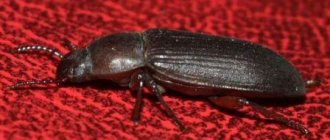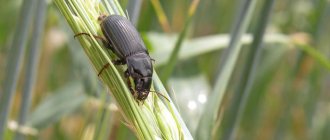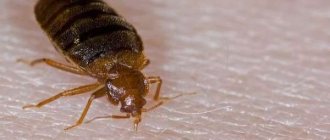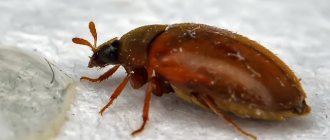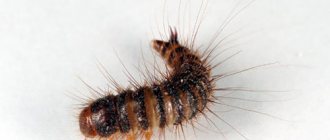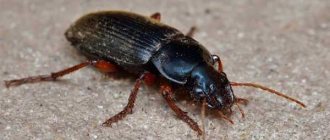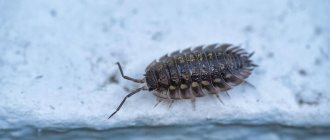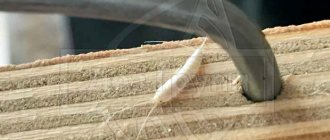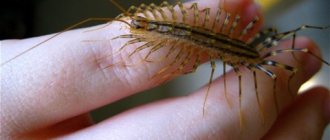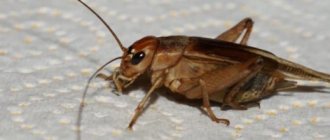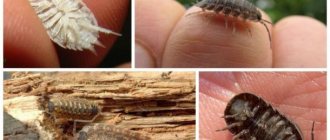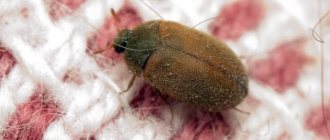- What kind of life does the beetle lead?
- A giant among the Khrushchaks
- Red flour beetle
- Horned beetle
- How to get rid of flour beetles
- Folk remedies for Khrushchak
- Chemicals
- Prevention
Brown or black bugs are lovers of grains, cereals, flour, bran and other similar products. Having appeared even in a cleanly cleaned apartment, the beetle hides in bulk food products, where larval worms then appear and eat up the supplies. It is not easy to detect pests, but it is not difficult to get rid of them in time. In order to drive out unwanted guests, it is worth getting acquainted with the appearance of the beetles, habits and methods of dealing with these beetles.
What kind of life does the beetle lead?
The beetle gets into the apartment with contaminated food at any time or at the end of summer, when adult insects are attracted by glowing light bulbs. In addition, pigeons carry eggs and larvae. Having penetrated the apartment, beetles settle in cereals and flour products.
Khrushchaki pests hide in the pantry and even in the underground if there are supplies there: the larvae feed on undried dried fruits, chocolate, nuts, cardboard and glue, natural silk and wool. Products after them are unsuitable for food, and even cause severe toxic damage to the body.
Khrushchev pests often choose places where there is no ventilation; they love humidity and mustiness. In private homes they hide among stockpiles of animal food.
An oblong beetle with strong jaws and a body length of 3.5-4 mm. The body is brown, red-brown or black. These beetles, once in an apartment or house, immediately breed offspring, which appear within a week.
And after 3 months the next generation comes out. While the females live, they lay 600-700 eggs, which are attached to the product with special mucus. The larvae, which are also called mealworms, grow up to 7 mm, are brown-yellow in color, and after molting, they become whitish or colorless.
Khrushchev with larvae can withstand frost of 5-6 degrees, and temperatures below 7 are destructive for them.
Interesting: in some Asian countries, larvae, a source of protein, are bred and eaten fried and boiled instead of meat. There are also lovers of such food in Russia.
How dangerous is it for humans?
The flour beetle eats almost everything. They don’t mind eating flour products, bran, other semi-finished products, etc. If they have no access to bulk foods, they can switch to other products, such as chocolate, nuts, dried fruits, glue, cardboard, knitwear, etc. . Food products that have been attacked by these pests are not suitable for further consumption.
Beetles and their larvae can be removed mechanically without any problems, but their eggs are much more difficult to remove due to their very small size. In addition, they are firmly held on any surface. While in food, pests leave behind waste from their vital activity: especially noteworthy is the special smell that cannot be gotten rid of.
There is evidence that the beetle larva can easily chew through burlap or tarpaulin. They can also handle bed linen, as well as other things made from natural ingredients. In addition, beetles can also harm pets. Since flour-eating beetles multiply quite quickly, you should not hesitate to destroy them.
On a note! Contaminated food should not be consumed as it has a certain level of toxicity. Various complications may develop, such as allergic reactions. Serious food poisoning is also possible.
A giant among the Khrushchaks
The length of the black or brown body of the large mealworm is 1.2-1.8 cm. The beetle can fly. Where the insect visits, the food smells sharp and unpleasant. Lifespan – 18 months.
Light yellow larval worms without eyes emerge from the eggs laid by the female in the food. With the help of their tenacious legs, they crawl, climb and make their way inside food. Before pupation, the larvae are already 3 cm long.
Biology
Description
The flour beetle, as this insect is also called, grows up to 18 millimeters in length. Its flat body has a brown-black, slightly shiny chitinous cover on top.
If we turn the insect over, we will see the brown abdomen of the beetle.
Spreading
The large flour beetle, and there is also a small one, but more about that later, is native to the Mediterranean, but has now spread throughout the world. The main places of its distribution are flour warehouses, grain barns and bakeries. But he can also live perfectly in your apartment.
In nature, the insect appears in mid-summer. At this time, its natural reproduction occurs, and the mealworm flies a lot from place to place. He especially likes to move in the direction of light or fire in the evenings.
Nutrition
Contrary to its name, the mealworm eats almost everything it comes across. His diet may include:
- cereal grains;
- pasta;
- raisin;
- dried fruits;
- dry corpses of dead animals and birds;
- bird feathers;
- wool;
- fabrics;
- starch;
- vegetable and fruit seeds.
To summarize this list, let's just say that the pest practically does not die from hunger.
Red flour beetle
The red-red pest is called the small mealworm, with a flat body length of 3-4 mm. This is an ancient inhabitant of the planet - beetles were found in Egyptian pyramids among the utensils of deceased pharaohs.
Flour beetles do not fly, they only run, unable to climb onto a vertical, smooth surface. Scaring off the enemy with an odorous liquid, it shows by smell where it lives. Insects are heat-loving - when the temperature drops to 0 degrees, they die after 3 days.
During the year, females lay 40-50 white eggs 5-6 times. Flour and dirt stick to sticky eggs, making them invisible. After 7 days, white 3-7 mm worm larvae emerge. With the help of triangular hook-shaped processes they climb like mountain climbers.
After 20-100 days, the already yellow larvae become yellow-white pupae. And a month later a sexually mature beetle appears. Insects live for less than six months.
Prevention
- Cereals, flour and other bulk products should be regularly inspected for the presence of pests. After all, beetles prefer to live in stale food. That is why you should not make too large reserves.
- Lack of humidity is another important condition that must be observed to prevent the spread of pests.
- For storing bulk products, it is preferable to use hermetically sealed containers.
- After using the contents of the container, it must be thoroughly washed and dried. This will help get rid of beetleworm eggs that may have remained on the surface of the container.
- Chamomile, bay leaf, garlic, lavender, and citrus zest will help prevent the spread of insects. Their smell repels pests.
How to get rid of flour beetles
The first thing to do if these beetles appear in your apartment is to throw away bulk products. If it’s a pity to throw away the cereal and flour, calcining it in the oven or freezing it at 10 degrees below zero will help kill the larvae and beetles.
It is worth remembering that the eggs are sown in other places, so the second thing is to do some general cleaning:
- wash with water and vinegar, then provide ventilation by opening the windows;
- spray or wipe the baseboards and adjacent floor with a chemical;
- Rinse open containers in vinegar solution, use hot steam or boiling;
- Place the products in a tightly sealed glass container.
Fighting methods
Flour beetle in the house
Knowing how to get rid of flour beetle at home, you can prevent its spread and thereby keep your supplies unspoiled. Sifting through contaminated products is not the best method of control. A similar procedure will help eliminate adult beetleworms and larvae, but most of the pest eggs will still remain in place.
- It is preferable to get rid of contaminated bulk products, legumes or dried fruits to avoid large-scale spread of insects.
- Dishes and furniture in which contaminated cereals were stored should be treated with a bleach solution.
- Housewives who want to preserve a supply of bulk products should thoroughly bake them in the oven.
- Due to the fact that flour beetles cannot tolerate extremely low temperatures, you can get rid of them by freezing.
- Kitchen cabinet shelves, walls and floors should be treated with vinegar or soda solution.
- All cracks under baseboards and other hard-to-reach places are treated with insecticidal preparations. For this you can use Pyrethrum or Dichlorvos. Phenax or Riapan powder will help with large-scale spread of insects. You can also lay out bait balls from powdered sugar, flour and borax, taken in equal quantities.
Remedies for flour beetle - After 2 weeks, the treatment should be repeated to destroy the surviving individuals.
Folk remedies for Khrushchak
As a pest repellent, use laurel leaves, lavender or Caucasian chamomile in the form of dried herbs, soaked swabs in a decoction, or choosing an aromatic essential oil.
If there are a lot of supplies, then steel hoops are put on the bags, metal lids and nails are placed on the dishes - the Khrushchaks do not like this metal. Beetles also cannot stand the smell of garlic and citrus, so garlic and lemon or orange peels are placed in jars of food.
Every month it is useful to treat cabinets and other food storage areas with a disinfectant solution: add 1 tbsp of soda and vinegar to 1 liter of warm water. l.
I use boric acid (borax) as bait - when eaten by a beetle, it poisons its body inside. Mix borax with powdered sugar or flour, semolina, honey or other products that attract the pest. Sprinkle on leaves and place on shelves in kitchen cabinets.
Professional processing
When there is a large concentration of insects, it is not always possible to destroy pests on your own. In such situations, it is necessary to seek help from special pest control services, whose experienced specialists have experience in dealing with household pests. It is contraindicated for children and pets to be in the room during this treatment. It would also be a good idea to take out food, indoor plants, children's clothes and toys.
Regular cleaning and proper storage of food are the most reliable and effective means of protecting food. By following these simple rules, you won’t have to fight the mealy bug. Well, if you happen to identify pests in a particular product, you should not hesitate or panic - you need to start fighting them as quickly as possible.
Chemicals
Among the chemicals used in apartments, pyrethroid chemicals are most often used:
- pirimophos,
- bifenthrin and other drugs.
These are tablets, solutions, gels and aerosols that are bought in the hardware department of stores.
When there are a lot of Khrushchak insects, there is no desire to fight them or it takes little time to destroy them, they invite specialist exterminators. Professionals spray the chemical using modern special equipment. Fine dust is created that penetrates everywhere.
Is it possible to breed at home?
The larvae are actively eaten by birds and insects. For this purpose, they are actively bred at home. The main thing is to adhere to the basic recommendations. It is better to grow pests in glass or plastic containers. The main thing is that the parasite does not get out and go to destroy the owner’s food supplies. The lid should be tight, but ventilation is required.
The larvae are raised to feed poultry
Bran, cereals, and bread crumbs are poured into the container. Additionally, you can put small pieces of cotton fabric and paper. Periodically pamper your pets with dried fruits, as well as fruits and vegetables. There are no drinking bowls. The insect drowns easily in water. The required temperature is 22-30 degrees.
Scientists are engaged in breeding Khrushchak. It is believed that beetles will save the environment in the future. In a short period of time, representatives eat not only leftover food, but also cellophane, which greatly pollutes the environment.
